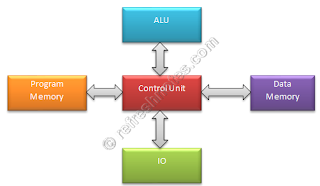Harvard Computer Model
- Separate Memory for Program and Data
- Separate signals or bus or path for accessing program and data memory
- Program and Data memory can be accesses simultaneously
- Program memory is read-only
- Data memory is read-write
- Impossible for program contents to be modified by program itself
- CPU can both read an instruction and perform a data memory access at the same time, even without a cache
- There is no need to make the two memories share characteristics. In particular, the word width, timing, implementation technology, and memory address structure can differ
- In some systems, there is much more instruction memory than data memory so instruction addresses are wider than data addresses
- It allows for different media for instruction and data. A cheap ROM and expensive RAM memory.
- It offers a level of code protection since code is stored in separate read only memory.
Related topics:
Von Neumann Architecture | Von Neumann Vs Harvard Architecture | Modified Harvard Architecture | Microprocessor Vs Microcontroller | Choosing a Microcontroller
List of topics: Microcomputer

No comments:
Post a Comment